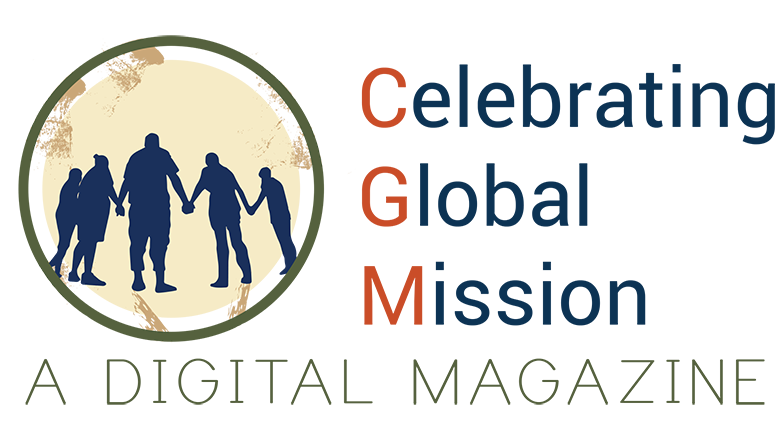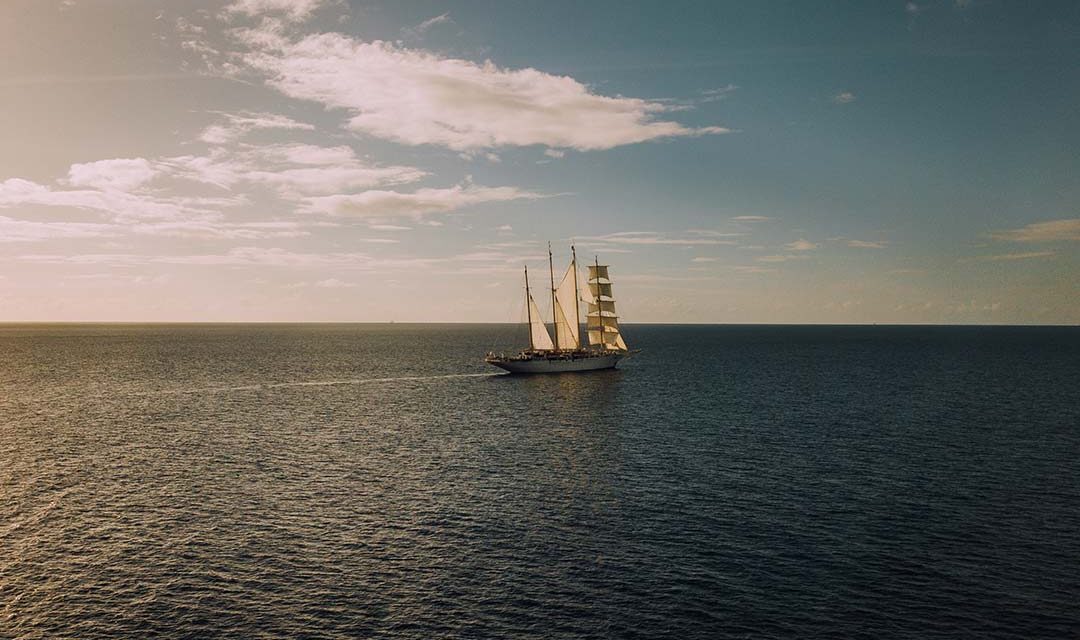Some Norwegian-American Lutheran Missionary Apostles
[This article is an edited version of a few chapters in the soon-to-be-published autobiography entitled “Rest of the Story” by Dr. Stanley Quanbeck. Dr. Quanbeck was a medical missionary in Madagascar for 40 years, 1964 – 2004.]
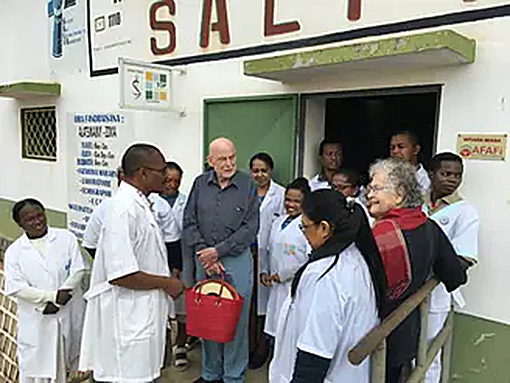
Dr. Stan Quanbeck with medical personnel
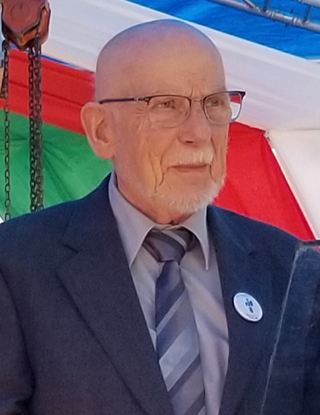
Dr. Stanley Quanbeck
In the secular world, those who are first into a given field or territory are often called pioneers. In the church, however, those who are the first to carry the Gospel Good News into another land or to a people who have not yet heard it, are called Apostles. In popular parlance, this term is often thought to be a special category of saint. In Biblical terms, however, the word apostle comes from the Greek work Apostolos, meaning “one who is sent”. An apostle isn’t, somehow, a uniquely special person. She or he is simply the one whom God chose for a specific and special task. This biblical idea is explained by St. Paul when he says, “I planted the seed [of the Gospel], Apollos [the teacher] watered it, but God has been making it grow. So, neither the one who plants nor the one who waters is anything, but only God, who makes things grow.” — 1 Corinthians 3: 6-7
I share here only some brief stories of these four missionary servants, to give the reader an idea of the great sacrifices and the service of these early church/gospel planters in whose line we followed. As St. Paul said so long ago, we each have striven to do our part in both planting and watering, but it is always God who provides the growth. To God alone be the glory!
Following are the stories of four important apostles of the Lord who had significant roles in the planting of the Gospel seed in Southern Madagascar.
Pastor John Peter Hogstad. We Call Him the First Apostle to the Tanosy People of Southeast Madagascar, 1887 – 1911.
Pastor John Peter Hogstad was the very first of the apostles sent out to Madagascar by the fledgling Norwegian-American Lutheran Church.
Jon Peder Hogstad was born on December 2, 1858, on his family’s farm near Trondhjem, the city where Norwegian kings are still crowned in the historic Nideros Cathedral. In 1866 the Hogstad family immigrated to America, eventually settling in Renville County about one hundred miles west of Minneapolis,Minnesota. In that Norwegian-American community Jon Peder soon Americanized his given names to John Peter. The Hogstads worshiped at the nearest church served by a series of Lutheran pastors deeply influenced by the Haugean revival movement.
At the time of his confirmation, Hogstad had not experienced a personal conversion experience, which Haugean congregations expected of their members. In Hogstad’s seminary application, he writes, “(as a youth) in defiance against my parents’ earnest admonitions, I was cold and indifferent about that which concerned my salvation.”
For some people, a spiritual awakening takes place because of a near death occurrence, e.g., Martin Luther’s encounter with a thunderstorm. In Hogstad’s case, a thunderstorm’s lightning bolt struck his house. He wrote:
When I later reflected how my life could have been extinguished and then I would have been eternally lost, I tried to pray but to no avail… for I did not feel properly repentant nor felt the promise of justification as I should have…. However, I did later receive a sense of union granted to me by the Grace of Christ and through faith I felt that Christ had taken me up into his fellowship. Since then, I have still found struggle and strife in life, but also that it is precious to listen to the Lord ‒ so that I want to hand over my cause to God’s hand and pray that the Lord’s will may be done.
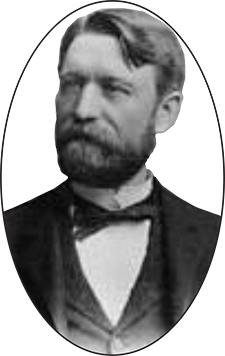
Georg Sverdrup
At Augsburg Seminary, Hogstad was deeply influenced by Georg Sverdrup, the school’s immensely talented president and “father” of American Lutheran Missions in Madagascar. Ten men graduated from Augsburg Seminary in 1887. Hogstad was ordained and commissioned at Augburg’s special “Missions Fest” event in June 1887. Just prior to his ordination, John married Oline Grodal, a Norwegian immigrant four years his senior.
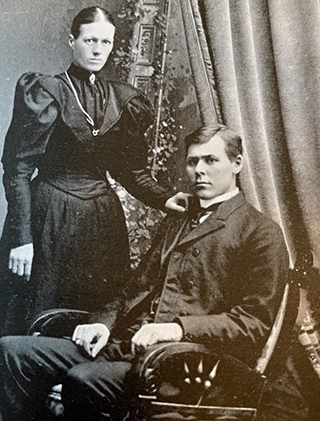
Rev. John (age 29) and Oline (age 33) Hogstad, 1887. Photo courtesy of 1926 Missionary Album, the Lutheran Board of Missions, Augsburg Seminary, Minneapolis, Minnesota.
Rev. John and Oline Hofstad were stationed at Fort Dauphin in the very southeast portion of Madagascar, where he established a congregation and school. Later, after a furlough and returning to Madagascar, they were located north of Fort Dauphin at Manantenina.
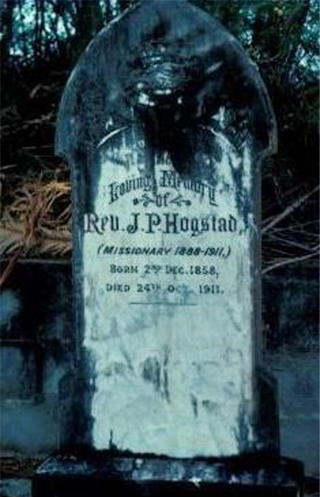
Rev. J. P. Hogstad grave marker, American Lutheran Cemetery, Fort Dauphin, Madagascar
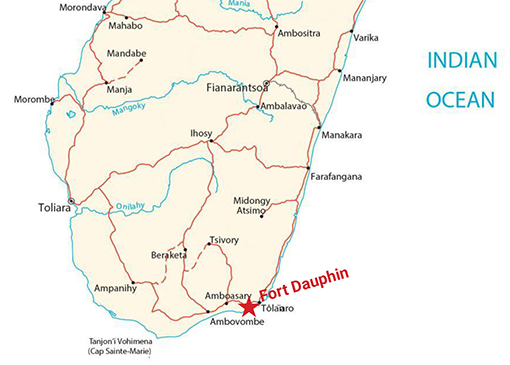
Map of Southern Madagascar with red star indicating Fort Dauphin
In 1911, having nearly completed the establishment of the new station in Manantenina, John became deathly ill from Blackwater Fever, a complication of malaria. Oline arranged for carriers to bring her husband to French doctors in Fort Dauphin. Somewhere during that three-day journey involving crossing six rivers by canoe, John lost consciousness. He died soon after arrival at Fort Dauphin. John’s body was buried in Fort Dauphin’s American Lutheran Cemetery located on a hill swept with constant easterly winds from the nearby Indian Ocean.
Pastor Eric Hansen Tou, the Second Apostle Sent Out. We Call Him the Apostle to Western Tanosy, 1889 – 1903.
Eric Hansen Tou was born near the city of Stavanger, Norway, on October 11, 1857. He emigrated to America at the age of 24 in 1881 and enrolled at Augsburg College the same year, graduating from the college with a Bachelor of Arts degree in 1886. He then enrolled in the Augsburg Seminary, receiving the Certificate in Theology in 1889.
Responding to Georg Sverdrup’s challenge to the Student Missionary Society at Augsburg, Tou presented himself as a candidate to go as a missionary to Madagascar. He was then ordained at Trinity Lutheran Church in Minneapolis, Minnesota, on May 12, 1889, becoming the second missionary from the Norwegian-American community to be sent out to Madagascar. Tou was married soon after to Elisabeth Caroline Knudsen. They departed for Madagascar and arrived at Tulear (now Toliara) in late November 1889.
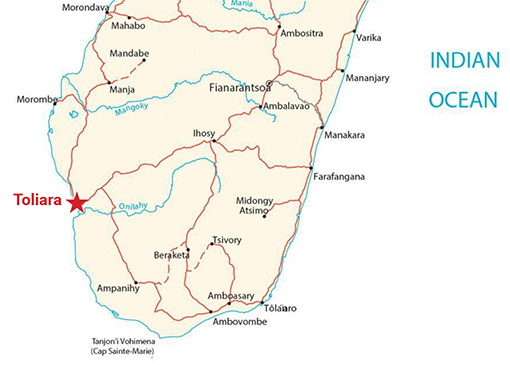
Map of Southern Madagascar map with red star indicating Tolaria (formerly Tolear)
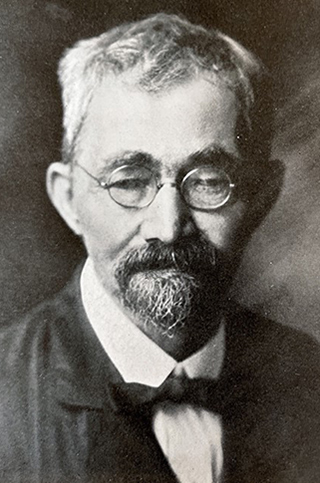
Pastor Eric Tou
Just learning to survive was the initial task that Eric and Elisabeth faced, while not forgetting that their primary reason for being there was to preach the Gospel. It was not easy to begin a Church in a land of non-believers. Tou reports that on December 11, 1891, the very first two Tanosy were baptized.
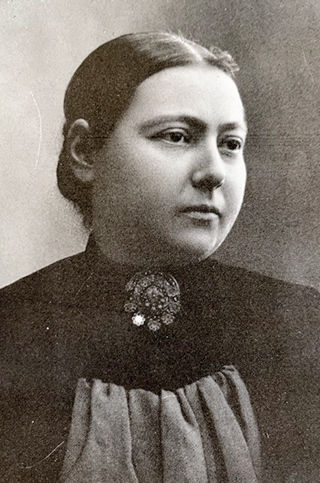
Elisabeth Tou
Early on, Tou had in his mind to prepare a school for the preparation of pastors and teachers to carry on and expand the work. His philosophy of Mission was that the evangelization of the Malagasy would best be accomplished by the Malagasy, not missionaries. By 1893 Tou had begun teaching three young men in anticipation of the beginning of a more formal school at Fanjahira, with the goal of preparing them to become catechists, evangelists, and later, pastors in the church.
Pastor Tou resigned as a missionary in 1903. The pain and difficulty of serving as a missionary were contributing factors for his resignation. Erik and Elisabeth Tao had already lost their first-born child in 1890, while still in St. Augustin, a boy named Hans Nils Herman Tau. Then, in 1901, their two-year-old son Herman died, soon to be followed by the death of his wife, Elisabeth, in childbirth. Several months after Elisabeth’s death, their infant daughter, Erika Elisabeth Caroline, also died. Thus, in the space of six months, three of his family had passed away, leaving him all alone with a four-year-old daughter, Anna, to care for.
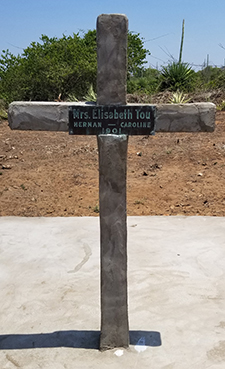
Elisabeth Tou grave marker
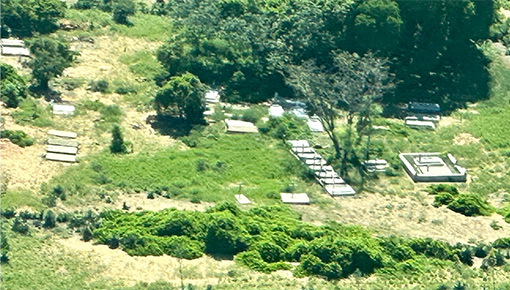
Aerial view of the 11 missionary graves in the Fanjahira Cemetery, January 2023. Photo courtesy of Glenn Quanbeck.
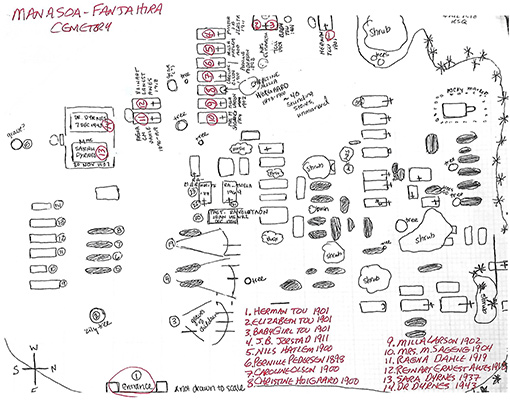
Fanjahira Cemetery plot map identifying graves of missionaries
Pastor Jakob Bernsten Jerstad, the Third Apostle Sent Out. We Call Him the Apostle to Mahafaly, 1898 – 1911.
Jakob Jerstad was born on the Jerstad farm at Kvinesdal, Norway, on September 18, 1865. Jakob was the fifth of twelve children born to Brent Elias Bernsten and Ingeborg Svendsdatter Jerstad. Kvinesdal is a small village in southern Norway. In those days, families with many children struggled to make ends meet. Thus, not surprisingly, 20 Kvinesdal-area young people, including Jakob Jerstad, left for America as a group in 1890. Jakob had a clear objective in going to America ‒ to study at Augsburg Seminary and become a pastor.
When he completed his seminary studies in 1898, Jakob was ordained and commissioned to serve in Madagascar under the auspices of the Norwegian Mission Society (NMS). But first things first: Jakob married Hannah A. Loney. Their union surely generated comments as Hannah, at five foot two inches in height, was short for a Norwegian woman, whereas Jakob, at six feet, was rather tall.
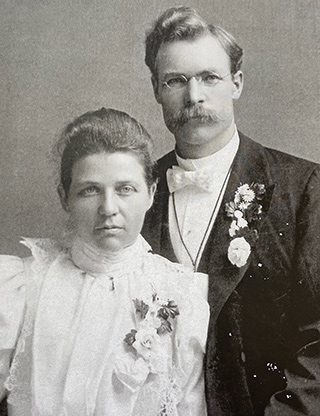
Pastor Jakob and Hannah Loney Jerstad. Photo from family archive.
Jakob and Hannah arrived in Fanjahira in 1898. They were assigned a primitive grass-thatched house where they lived and studied the local language. In 1899, they were moved to a better thatched house in the village of Vohimary, about 15 km northwest of Fanjahira. One Sunday after church services that lasted all day, a kitchen fire spread to and destroyed that new house. Jakob and Hannah lost all their belongings, so they moved back to Fanjahira.
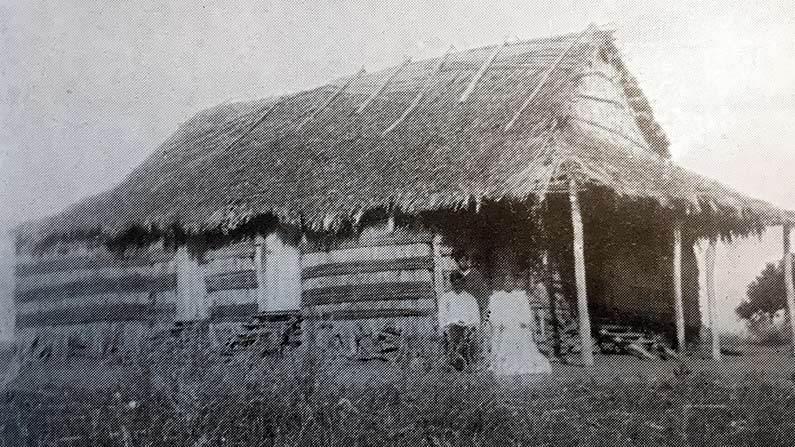
The Jerstad house in Mahafaly land
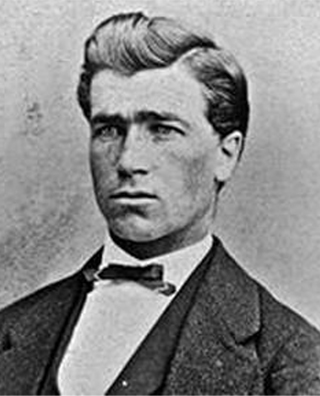
Rev. Lars Røstvig
The first Protestant missionary to venture into the Mahafaly tribal region was Rev. Røstvig of the NMS. There Røstvig was summarily ordered to leave and was warned that the next white person to show up south of the Onilahy River would be killed. The strong Mahafaly taboo against vazaha (foreigners) was based on the belief that ancestral spirits saw contact with vazaha as calamitous for the tribe.
In 1900, Jakob had contacted Georg Sverdrup at the Lutheran Free Church’s mission headquarters in Minneapolis, requesting permission to relocate south of the Onilahy River to begin work among the Mahafaly tribe. When that request was granted, Jerstad and Dr. Dyrnes made an exploratory trip across the river. They determined that an elevated piece of land not far from the river would be a suitable building site. In 1901, Jerstad not only crossed into Mahafaly land but also built a house and settled there with his family.
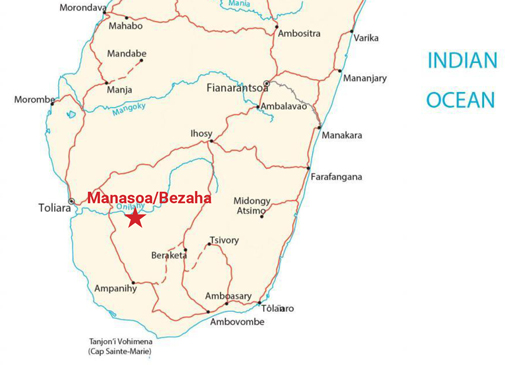
Map of Southern Madagascar with red star indicating the Manasoa/Bezaha area
The Mahafaly people had a plethora of taboos, too many to recount but must be strictly observed. Transgression brings disaster of some sort to the offender, his family, or his property. Fear of inevitable fate leads the people to heed these strange commandments. And when trouble hits, it is not surprising that the Mahafaly seek solutions from the ombiasa (witch doctors).
As an apostle of the Gospel, Jerstad writes about ministering to these people:
Every man or woman of faith will easily understand that a people in such bondage to superstition and thus tormented by the inescapable demands of fate, must be an unhappy people. The commandments are many, and therefore, the transgressions are many, leading to constant anxiety and the fear that fate will overtake them. May we not dare hope that a people who obey and observe so many commandments would be faithful to the true commandments of the Lord, once they were truly converted and came to the knowledge of the truth? And shall we not both pray and work strenuously toward the goal that these people, who are so bound by the power of superstition and so loaded down with Satan’s bands and chains, would be freed from the snares of the devil in which they are trapped, freed to do His will? There is hope. “Have faith in God!”
“Ye shall know the truth, and the truth shall make you free”(John 8:32).
In May 1911 at the age of 46, Jakob died in Manasoa, Madagascar, and is buried in the Fanjahira Cemetery.
Dr. John Dyrnes Tou, the Fourth Apostle Sent Out. We Call Him the Southern Madagascar Lukeian Apostle, 1900 – 1943.
Dr. John O. Dyrnes was the first medical missionary sent out by the Norwegian-American Lutherans. We refer to him as Southern Madagascar’s Lukeian Apostle (after St. Luke who was both an historian and a physician).
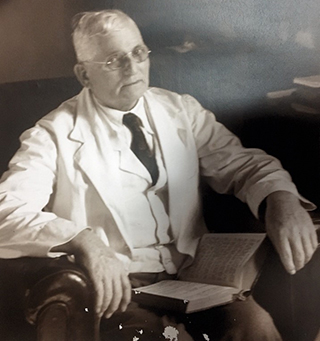
Dr. John O. Dyrnes
John Dyrnes was born in Norway in 1863. At the age of 16, Dyrnes immigrated first to Ashland, Wisconsin, then in the fall of 1889 he entered Augsburg College and graduated in 1892. In 1895, Dyrnes earned his theology degree from Augsburg Seminary while continuing his education at the Minneapolis College of Physicians and Surgeons, which then was affiliated with Hamline University, and received his M.D. degree in 1898. Later that year, Dyrnes was called by the Lutheran Board of Missions of the LFC to serve in Madagascar.
Dr. Dyrnes arrived at Fanjahira in 1900 and quickly became aware of the many earlier missionaries who had died of Malaria and were buried in Fanjahira Cemetery. Dr. Dyrnes attributed this to the proximity of rice fields where the deadly Anopheles mosquito bred and thrived. Having attended lectures at the Medical School of Paris, Dyrnes had learned of the recently validated theory that it was mosquitoes that transmitted Malaria from one sick person to another. The prevailing belief up until that time was that Malaria was caused by “Mal-air” or “bad air”.

Map of Southern Madagascar with red star indicating the Manasoa/Bezaha area
In 1904, Dyrnes moved his medical clinic and his teaching to a location about one kilometer north of Fanjahira and named the new mission location Manasoa (literally: “having goodness”). Dyrnes believed that being further away from the rice fields would decrease the chances of being bitten by the Malaria-carrying mosquitoes.
Dr. Dyrnes worked as a medical missionary in the Manasoa/Bezaha area for 43 years, dying in December of 1943. During his work in Madagascar, he also was bold in proclaiming the Gospel to the people he treated. He saved babies who were declared to have been born on an evil day and were to left to die on anthills or in cattle pens to be trampled to death. Dr. Dyrnes saved these babies and eventually began a school to educate these children. His clinic had a stone at its entrance and when he died, the stone was placed at the foot of his grave. The stone had worn down from the bare feet of his patients such that there now was a large depression in the stone.
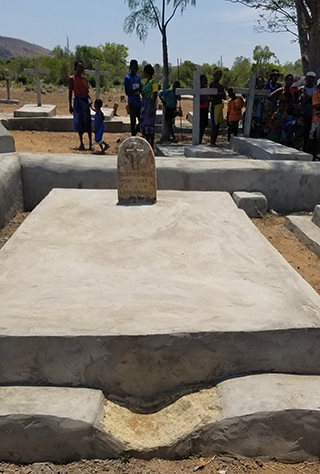
Grave of Dr. Dyrnes
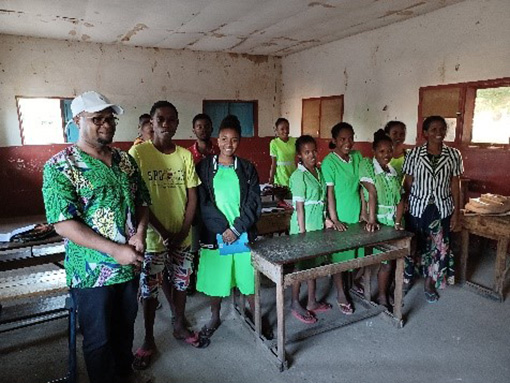
Today’s Dr. John Dyrnes school in Bezaha, Madagascar
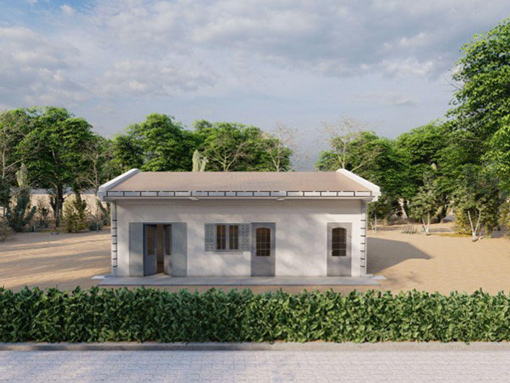
A drawing of one of three clinics Friends of Madagascar Mission is funding in southwest Madagascar, where there are few healthcare facilities
To God Be the Glory!
And so, these four pioneers and hundreds of others came to Madagascar to serve as missionaries, to plant the seed of the Gospel. The Lutheran Christian Church has grown so that today there are nearly four million members of the Malagasy Lutheran Church! The church is evangelism focused, training evangelists, catechists, pastors to be the new apostles. In addition, they have humanitarian programs: schools for the blind and deaf, a nursing school, and a large medical program called SALFA with 10 hospitals and numerous clinics and dispensaries.

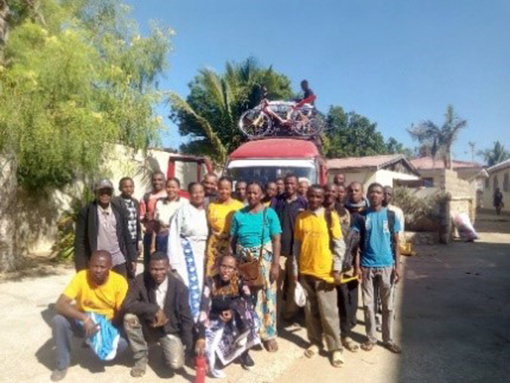
A photo of several evangelists who attended an evangelist training event, June 2023
